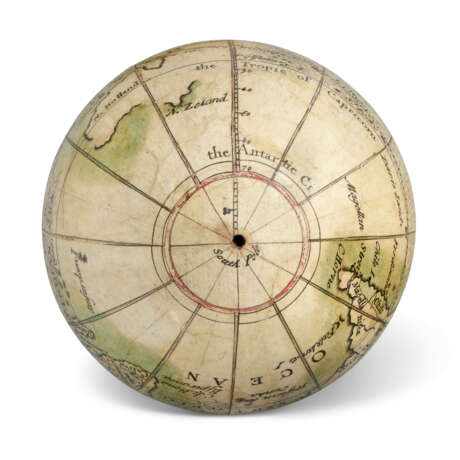ID 1249880
Lot 114 | PRICE, Charles (fl.1697-1733)
Estimate value
£ 10 000 – 15 000
AN ENGLISH 3-INCH POCKET GLOBE, CIRCA 1720
An extremely rare example of an early English pocket globe.
The laurel-leaf border cartouche identifies Charles Price as the maker of this pocket globe. He was apprenticed to John Seller in 1693, and worked from a number of London addresses in collaboration with various other map and globe makers throughout his career. He partnered with John Senex (1678-1740) from 1706-1710 and produced a slightly smaller, 2¾-inch pocket globe (see Lot 113). The signature on this pocket globe is printed in a similar, laurel-leaf-bound cartouche, signed New & Correct GLOBE w.th Trade Winds &c By C. Price & I. Senex Geographers.
Whether Price produced the 3-inch pocket globe before or after the Senex partnership (1706-1710) is more ambiguous. There are two exemplars of Price's pocket globe in institutions, both with more colouration (continents in sharper yellows, greens, reds and pinks, as opposed to our globe's more subtle wash of greens and yellows). The McCord Stewart Museum in Montreal, Canada dates their Price pocket globe to c.1701 (object number: 1984.29.1 ab), whilst the Science Museum in London dates their pocket globe to 1716. Neither provides conclusive dating.
Price continued to publish cartographical works and globes well into the 1710s and 1720s, although these were mainly in joint ventures with other map and globe makers. It was only later in Price's career when he began to publish works independently: A Compleat Sea Atlas (1727); Atlas of Sea Charts (1730); A Correct Map of the County of Sussex (1730); and A Correct Chart of Scilly Islands (1730) amongst others. This increase in independent output may have led to the financial difficulties which landed Price in Fleet Prison, where he is a debtor recorded at the of 1731, confined possibly until his death in 1733.
Price's pocket globe, although larger in size, is in many ways a simplification of the work done with John Senex on the pocket globe of 1710. There is no longer the London meridian, the Virgil quotation around the north pole, or Drake's circumnavigation route (although John Senex would do away with these details too - apart from the London meridian - in his later iteration of the pocket globe post his election to the Royal Society; he indeed goes on to sign By I. Senex F.R.S.). The typography on Price's globe is significantly different too, although the geography is mostly the same in the joint venture with Senex and there is still the conflation of New Zealand with Tasmania (the island of New Zealand omitted). Two completely different plates were evidently used, both for the celestial and terrestrial gores, in the joint venture with Price and Senex and Charles Price's independent pocket globe. The Price pocket globe in larger format and with a simpler typography shows a variation that prioritises clarity over compact detail. On such a small scale, Price's pocket globe here gives a marvelously clear rendition of the early-eighteenth-century earth and skies.
The globe comprised of twelve hand-coloured engraved gores and two polar calottes, the laurel leaf-border cartouche signed C. Price Fecit, the terrestrial globe with graduated equator, the meridian at 175°W and graduated in degrees, Tropic and Polar circles labelled, with inner polar circles in red, the oceans with trade winds shown by arrows and dashes, the Newfoundland bank and Dampier Straits shown, Australia labelled N. Holland and part delineated, connected to New Guinea, New Zealand assigned to Tasmania and New Zealand itself not drawn, Japan shown as an island and as two portions of coastline bordering a strait and labelled Land of yedso and Iapon, north-eastern Asian labelled Incognita, the Caspian Sea shown, Central Africa labelled Ethiopia with Incognita in two places, Greenland and Canada without northern coastline, California as an island, no hypothetical southern continent; contained in a spherical fishskin-covered case, each interior hemisphere lined with two sets of twelve hand-coloured engraved celestial gores and two polar calottes, the equatorial and ecliptic graduated in degrees, the ecliptic unnumbered but with sigils for the houses of the Zodiac, Cor Caroli depicted, the stars to several orders of magnitude, the constellations depicted by mythical beasts and figures in red, yellow and green, the cover with two brass hooks and eye clasps.
3 1/8in. (7.9cm.) diameter in case
| Artist: | Charles Price (1697 - 1733) |
|---|---|
| Auction house category: | All other types of objects, Pocket watches |
| Artist: | Charles Price (1697 - 1733) |
|---|---|
| Auction house category: | All other types of objects, Pocket watches |
| Address of auction |
CHRISTIE'S 8 King Street, St. James's SW1Y 6QT London United Kingdom | |
|---|---|---|
| Preview |
| |
| Phone | +44 (0)20 7839 9060 | |
| Buyer Premium | see on Website | |
| Conditions of purchase | Conditions of purchase |











